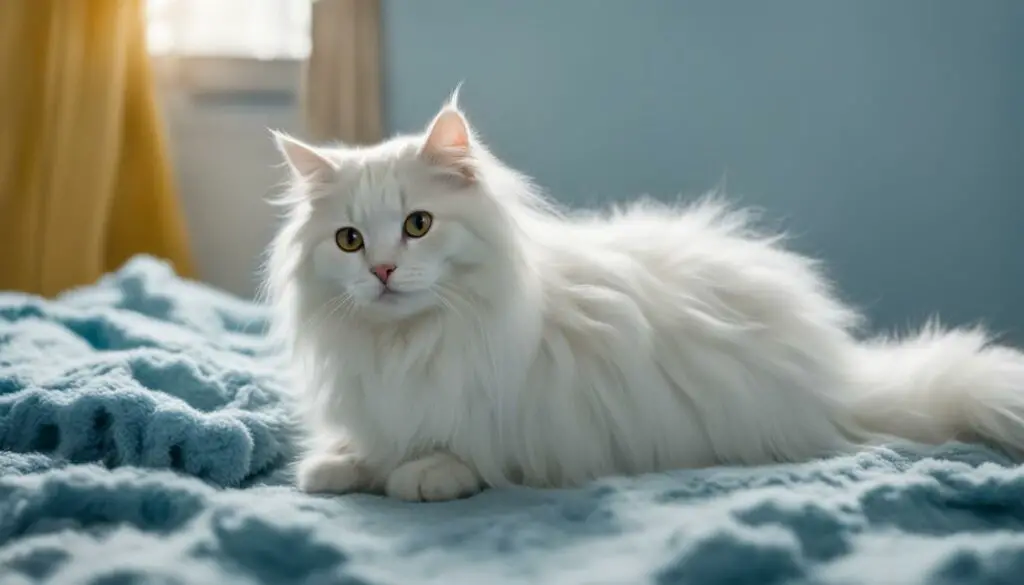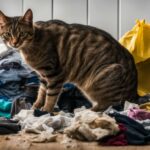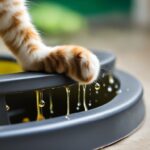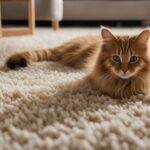Dealing with a cat that pees on soft things can be frustrating and confusing. It’s important to remember that your cat isn’t doing it to spite you; they are trying to communicate something. By understanding the reasons behind this behavior, you can find solutions and prevent future accidents.
Key Takeaways:
- Cat urine outside the litter box is a common issue faced by many cat owners.
- Cats may pee on soft things to mark their territory or due to inter-cat conflicts.
- Litter aversion and underlying medical conditions can also cause inappropriate urination.
- Prevention strategies include providing a stress-free environment, using the right litter, and maintaining cleanliness.
- Professional help may be necessary if the problem persists despite your efforts.
Your Cat is Marking Their Territory
One possible reason why your cat may be peeing on soft things is because they are marking their territory. Cats are territorial animals and use urine marking as a way to communicate and establish boundaries. This behavior often occurs in response to perceived threats or intrusions by other cats in the household or in the surrounding environment.
To address this territorial marking behavior, there are several strategies you can try. One option is to use plug-in solutions that release synthetic pheromones, which can help create a calming environment for your cat. These pheromones mimic the scent produced by cats when they feel safe and secure, reducing the need for urine marking. Another option is to use chill-out tonics or treats that contain natural herbs known for their calming properties. Some cat owners have also found success in using cannabis or hemp-based products specifically formulated for cats. In severe cases, consulting with your veterinarian may be necessary to explore medication options to help reduce territorial marking behavior.
It’s important to note that addressing territorial marking may also require addressing any underlying conflicts between cats in the household. If you have multiple cats, it’s essential to provide each cat with its own resources and space. This means having separate litter boxes, feeding areas, and resting spots for each cat. By ensuring that each cat has their own designated territories, you can help reduce the need for marking and promote a more harmonious living environment.
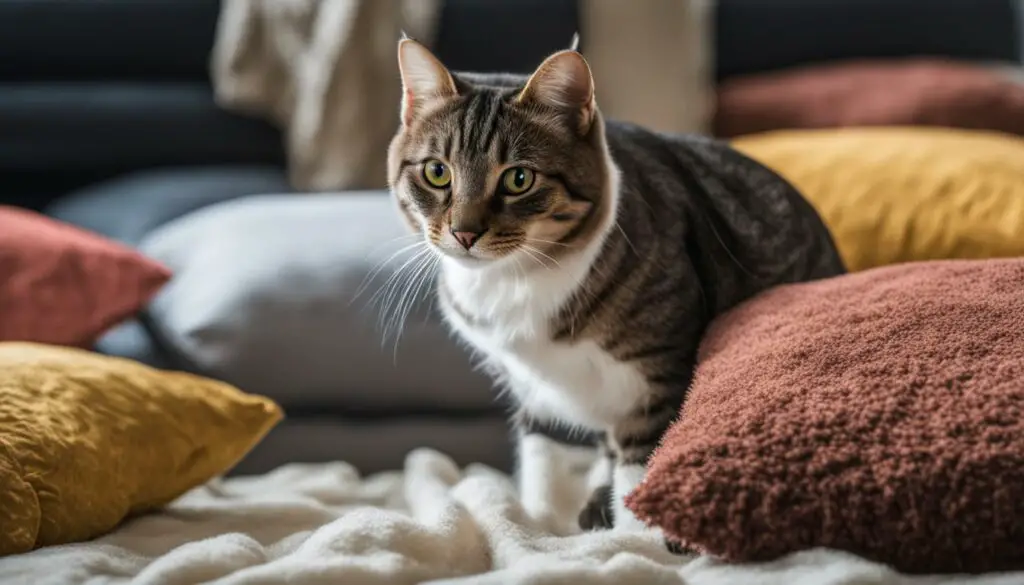
Common Signs of Cat Territorial Behavior:
- Spraying or urine marking on vertical surfaces, such as walls or furniture
- Scratching furniture or other objects to leave visual and scent marks
- Aggressive behavior towards other cats or animals in the household
- Guarding particular areas or resources, such as food bowls or resting spots
Understanding why your cat is marking their territory and implementing appropriate strategies can help reduce this behavior and prevent urine accidents on soft items in your home.
There’s Infighting with Another Cat in the Home
If you have multiple cats, inappropriate urination may be a result of inter-cat conflicts and dominance issues. The more dominant cat may prevent the other cats from using the same litter box, leading to accidents on soft items. To address this problem, it’s essential to provide multiple litter boxes in different locations. Ideally, there should be one litter box per cat, plus an extra one to ensure access for all cats.
By offering multiple litter boxes, you reduce competition and create a more harmonious environment for your cats. It helps to establish a clear hierarchy and prevents the need for marking territory. Remember to place the litter boxes in quiet and easily accessible areas, ensuring privacy for each cat. This setup reduces stress and promotes proper litter box usage.
In addition to providing multiple litter boxes, it’s crucial to observe your cats’ interactions and address any signs of aggression or tension. If you notice one cat consistently dominating the others or preventing access to essential resources, such as food, water, or litter boxes, it’s crucial to intervene. Consult a professional cat behaviorist who can provide guidance on how to manage inter-cat conflicts effectively.
Establishing Peaceful Coexistence
Creating a peaceful coexistence among cats requires patience and consistent effort. Here are a few additional strategies you can implement to promote harmony:
- Ensure each cat has their own feeding area and separate bowls to prevent food-related conflicts.
- Provide vertical spaces and hiding spots, such as cat trees or shelves, so cats can escape and have their private spaces.
- Encourage positive interactions by engaging in play sessions together. This helps them build positive associations and strengthen their bond.
- Consider using pheromone diffusers or calming sprays to create a calm and stress-free environment.
By taking these measures, you can establish a peaceful and harmonious living environment for your cats, reducing the likelihood of inter-cat conflicts and preventing the need for inappropriate urination on soft items.
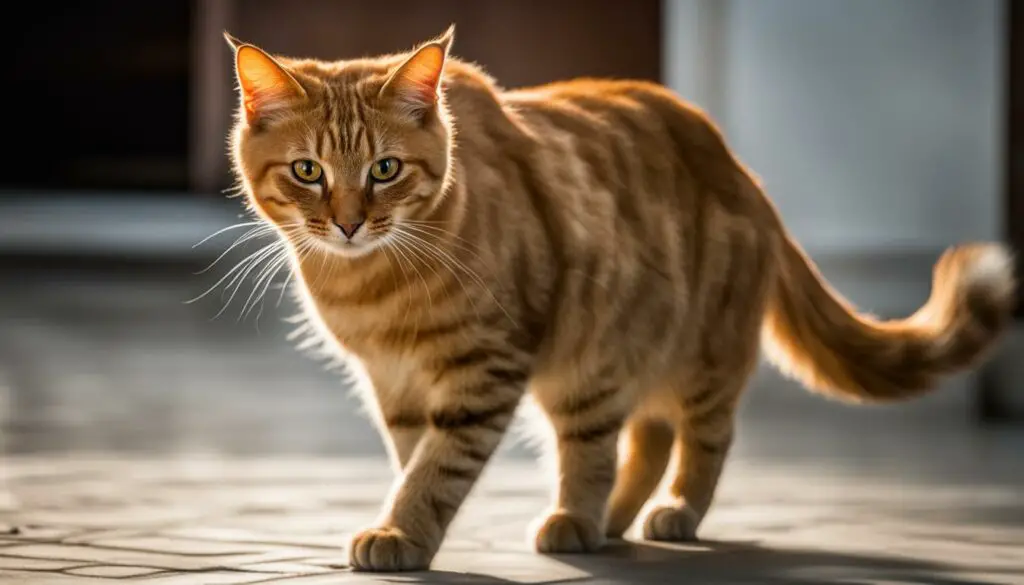
Your Cat Hates Their Litter
If your cat is peeing on soft things, it could be because they dislike their litter. Cats have specific preferences when it comes to the texture and scent of their litter, and if they find it unpleasant, they may seek alternative places to relieve themselves. To address this issue, it’s important to choose the right cat litter that your furry friend will enjoy.
Table: Different Types of Cat Litter
| Type of Cat Litter | Advantages | Disadvantages |
|---|---|---|
| Clay litter | Good odor control | Dusty, non-biodegradable |
| Clumping litter | Forms easy-to-scoop clumps | Can stick to cat’s paws |
| Crystal litter | Excellent odor control | Can be expensive |
| Paper-based litter | Environmentally friendly | May not control odors as effectively |
Experiment with different types of litter to find the one that your cat prefers. Consider their preferences for texture, scent, and clumping ability. It’s also important to keep the litter box clean and free of waste. Cats are naturally clean animals, and a dirty litter box may discourage them from using it.
If your cat continues to display litter aversion despite trying different brands and types of litter, you can also try using litter attractants. These products are formulated to entice cats to use the litter box. They can be particularly helpful in retraining cats who have developed a preference for inappropriate peeing habits.
Your Cat Is Actually Sick
In some cases, inappropriate urination can be a symptom of an underlying medical condition. If your cat is consistently peeing on soft items and not using the litter box at all, it may be a sign of illness. Common health issues include urinary tract infections, kidney disease, diabetes, and endocrine disorders. If you suspect a medical issue, it’s crucial to consult with your vet. They can perform tests and provide appropriate treatment.
Symptoms of Medical Causes of Inappropriate Urination
- Consistent peeing on soft items
- Not using the litter box at all
- Excessive thirst and urination
- Weight loss
- Changes in appetite
- Blood in the urine
“If your cat is consistently peeing on soft items and not using the litter box at all, it may be a sign of illness.”
It’s important to monitor your cat’s behavior and look out for any signs of potential health issues. If you notice any of the symptoms mentioned above, it’s crucial to seek veterinary assistance as soon as possible. Early diagnosis and treatment can help manage and improve your cat’s health, ultimately resolving the issue of inappropriate urination.
Remember, your cat’s health should always be a top priority. By addressing any medical causes, you can ensure your cat’s well-being and prevent further instances of inappropriate urination.
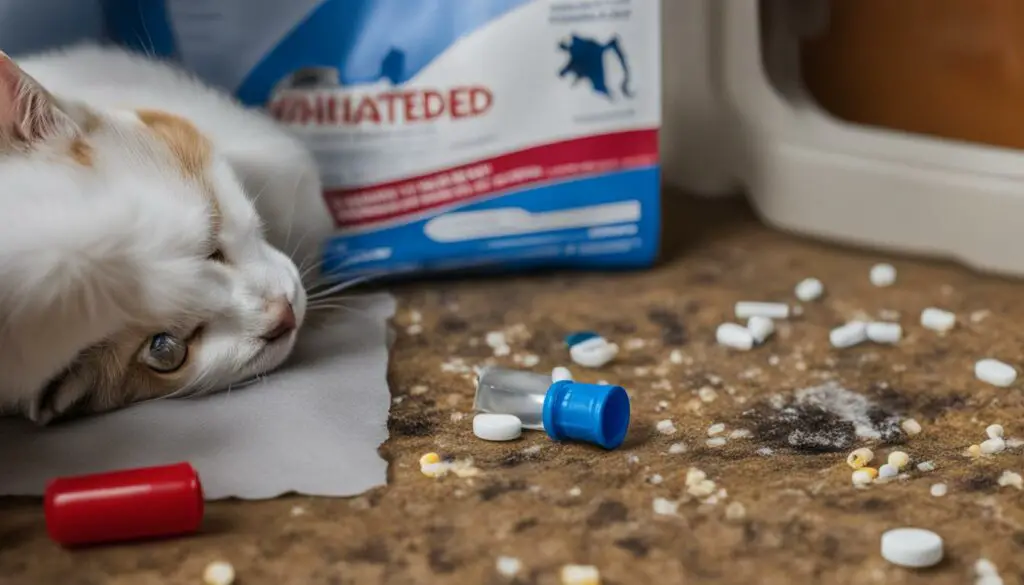
Preventing Inappropriate Urination
Dealing with a cat peeing on soft things can be challenging, but there are steps you can take to prevent it. Firstly, ensure that your cat’s litter box is in a quiet and private location. Cats prefer to have some privacy while using the litter box, so placing it in a peaceful spot can encourage them to use it consistently. Additionally, make sure you are using a litter type that your cat prefers. Some cats have specific preferences when it comes to litter texture and scent, so experiment with different options until you find one that your cat enjoys.
Providing enough litter boxes is also crucial, especially if you have multiple cats. The general guideline is to have one litter box per cat, plus an extra one. This ensures that all cats have access to a box when needed, reducing the likelihood of accidents on soft items. Place the litter boxes in different locations throughout your home to make them easily accessible for all cats. This helps to prevent dominance issues and minimize stress in multi-cat households.
Regular cleaning of the litter boxes is essential in preventing inappropriate urination. Cats are naturally clean animals and may avoid using a dirty litter box. Scoop the box at least once a day and completely change the litter every one to two weeks, depending on your cat’s preferences. Keeping the litter box clean and fresh will encourage your cat to use it, rather than seeking alternative places to relieve themselves.
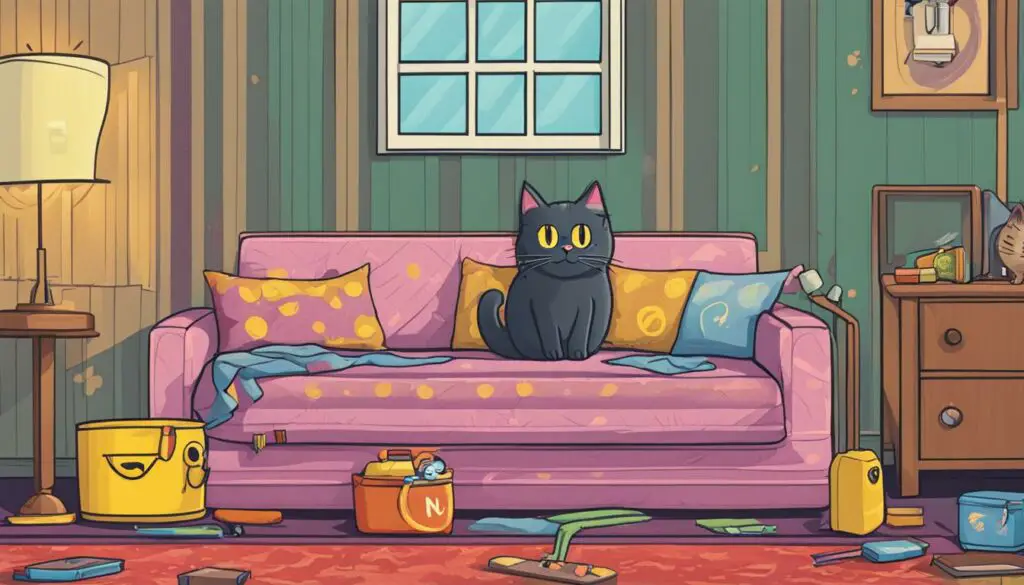
If your cat is still exhibiting inappropriate urination despite these strategies, it may be helpful to consult with a veterinarian or a professional cat behaviorist. They can assess your cat’s behavior, identify any underlying issues, and provide further guidance on preventing and addressing the problem. With patience, understanding, and the right approach, you can successfully prevent your cat from peeing on soft items and maintain a harmonious relationship with your furry friend.
The Importance of Routine and Environment
Creating a consistent routine and providing a stress-free environment is crucial for your cat’s well-being. Cats thrive on routine, and sudden changes in their environment can trigger inappropriate urination. Therefore, it is essential to maintain a consistent schedule and avoid disruptions to your cat’s daily routine to reduce stress and anxiety.
Additionally, creating a calm and secure environment for your cat is vital in preventing them from peeing on soft things. Minimize loud noises and introduce new pets or family members gradually to avoid overwhelming your cat. Providing plenty of hiding spots and vertical spaces allows your cat to feel secure and in control of their surroundings.
Remember, cats are sensitive creatures, and they rely on familiar routines and a peaceful environment. By establishing a consistent routine and providing a stress-free environment, you can help reduce the likelihood of your cat peeing on soft items.
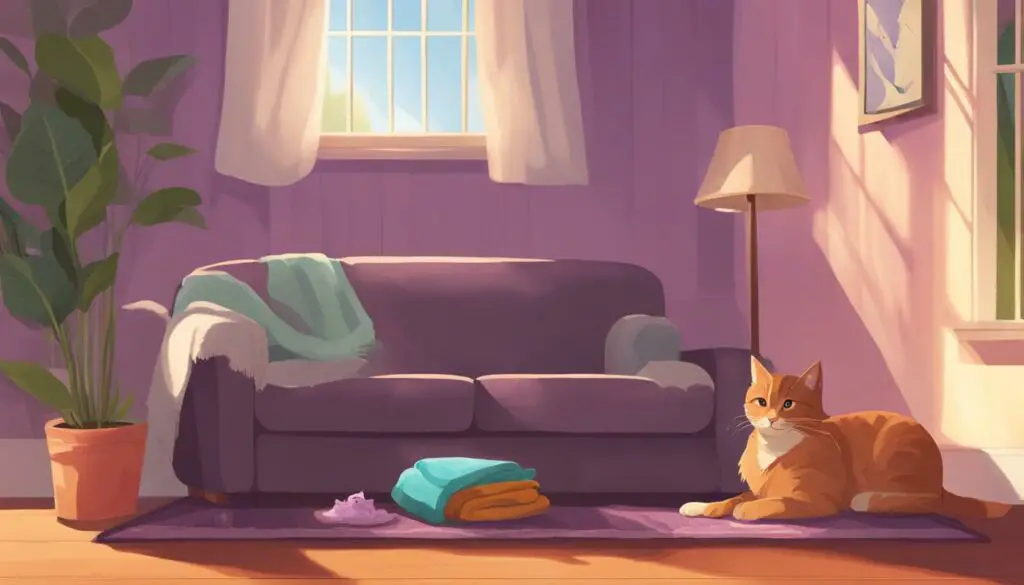
The Benefits of Routine and Environment for Cats
- Routine provides stability and reduces stress
- A calm environment fosters a sense of security
- Consistency helps prevent anxiety-related behaviors, such as inappropriate urination
- A stress-free environment promotes overall well-being
“A relaxed and predictable routine, coupled with a secure environment, can significantly contribute to your cat’s happiness and behavioral health.” – Dr. Jane Johnson, Feline Behavior Specialist
Tips for Establishing a Consistent Routine
- Feed your cat at the same time every day
- Designate specific playtime and interactive sessions
- Maintain a consistent schedule for litter box cleaning
- Ensure your cat has access to fresh water at all times
Creating a Stress-Free Environment for Your Cat
- Minimize loud noises and sudden changes
- Introduce new family members or pets gradually
- Provide plenty of hiding spots and vertical spaces
- Make sure your cat has a designated, quiet area for relaxation
| Benefits of Routine and Environment | Tips for Establishing a Routine | Creating a Stress-Free Environment |
|---|---|---|
| Routine provides stability and reduces stress | Feed your cat at the same time every day | Minimize loud noises and sudden changes |
| A calm environment fosters a sense of security | Designate specific playtime and interactive sessions | Introduce new family members or pets gradually |
| Consistency helps prevent anxiety-related behaviors | Maintain a consistent schedule for litter box cleaning | Provide plenty of hiding spots and vertical spaces |
| A stress-free environment promotes overall well-being | Ensure your cat has access to fresh water at all times | Make sure your cat has a designated, quiet area for relaxation |
Maintaining Cleanliness and Odor Control
When dealing with a cat that pees on soft things, it’s crucial to focus on maintaining cleanliness and controlling odor. Cat urine can leave behind a strong and unpleasant smell that can be difficult to get rid of. To prevent repeat incidents and keep your home fresh, follow these tips:
- Thoroughly clean up cat urine accidents using enzyme cleaners specifically designed for removing cat urine odor and stains. These cleaners break down the enzymes in the urine and eliminate odors effectively.
- Avoid using ammonia-based cleaners, as they can actually attract your cat to urinate in the same spot again. Stick to enzyme-based cleaners to ensure you’re removing all traces of urine odor.
- Consider using additional odor control products, such as air fresheners or candles, to help mask any remaining odors and keep your home smelling fresh.
By maintaining cleanliness and controlling the odor associated with cat urine, you can create a more pleasant living environment for both you and your cat. Remember to consistently monitor and clean any accidents promptly to prevent re-marking.
| Product Name | Description | Price |
|---|---|---|
| Enzyme-based Cleaner | A specially formulated cleaner that breaks down the enzymes in cat urine, effectively eliminating odors and stains. | $12.99 |
| Odor Control Spray | A spray that helps mask and neutralize lingering urine odors in the air, leaving your home smelling fresh. | $8.99 |
| Cat Litter Deodorizer | A powder or granular product that can be sprinkled onto your cat’s litter to control odors and keep the litter box smelling fresh. | $6.99 |
“Maintaining cleanliness and controlling odor are essential when dealing with a cat that pees on soft things. By using enzyme cleaners, avoiding ammonia-based products, and incorporating odor control products, you can create a fresh and pleasant living environment for both you and your feline companion.” – Cat Lover Magazine
Seeking Professional Help
When dealing with cat behavior problems, it’s essential to consider seeking professional help. A cat behaviorist or a veterinary behaviorist can provide valuable insights and guidance to address your cat’s urination issues effectively. These professionals have extensive knowledge and experience in understanding feline behavior and can help you identify and resolve the underlying causes of your cat’s inappropriate urination.
A cat behaviorist will conduct a thorough assessment of your cat’s behavior, taking into account factors such as their environment, interactions with other pets, and any medical history. Based on their evaluation, they will develop a customized plan tailored to your cat’s specific needs. This plan may include behavior modification techniques, environmental enrichment strategies, and recommendations for appropriate training and socialization.
A veterinary behaviorist is a veterinarian who specializes in animal behavior. They can rule out any potential medical reasons for your cat’s urination problems and provide appropriate medical interventions if necessary. They will work closely with you and your cat’s regular veterinarian to ensure comprehensive care and treatment.
It’s important to remember that seeking professional help is not a sign of failure as a pet owner. Cats are complex creatures, and their behavior can be influenced by various factors. By consulting a professional, you can gain valuable insights and access to effective strategies to help your cat overcome their urination issues and improve their overall well-being.

Benefits of Professional Help:
- A professional can provide expert advice and guidance tailored to your cat’s specific needs.
- They can help identify and address the underlying causes of your cat’s inappropriate urination.
- Professional intervention can lead to effective behavior modification and long-term solutions.
- They can offer support and guidance throughout the process, ensuring you and your cat receive the care you need.
Establishing a Consistent Cleaning Routine
When it comes to managing cat urine accidents, establishing a consistent cleaning routine is crucial. Prompt and thorough cleaning not only eliminates odors but also helps prevent re-marking behavior. Follow these steps to effectively clean up cat pee accidents:
- Start by blotting up any excess urine with paper towels. Avoid rubbing or smearing the urine, as it can spread the odor and stain.
- Apply an enzyme cleaner specifically designed for removing cat urine. These cleaners break down the urine enzymes and eliminate odors effectively. Follow the product’s instructions for the best results.
- Allow the cleaner to sit on the affected area for the recommended time. This gives the enzymes enough time to break down the urine molecules and remove the odor completely.
- After the recommended time, blot the area again with clean paper towels to remove the excess moisture and cleaner.
- If necessary, rinse the area with water to ensure all traces of the cleaner are removed.
- Repeat the cleaning process if the smell persists. In some cases, multiple cleanings may be required to completely eliminate the odor.
By following a consistent cleaning routine, you can effectively remove cat urine odors and discourage your cat from re-marking the same spot.
| Cleaning Supplies | Description |
|---|---|
| Enzyme Cleaner | An enzyme-based cleaner specifically formulated for removing cat urine. It breaks down urine enzymes and eliminates odors effectively. |
| Paper Towels | Used for blotting up excess urine and cleaning the affected area. |
| Water | Used for rinsing the area after using the enzyme cleaner. |
Remember, it’s crucial to use products and methods that are safe for both you and your cat. Avoid using ammonia-based cleaners, as the smell can resemble that of cat urine and may attract your cat to the same spot. Additionally, be sure to test any new cleaning products on a small, inconspicuous area before applying them to larger areas.
Creating Positive Associations with the Litter Box
Encouraging your cat to use the litter box involves creating positive associations with this specific area. By making the litter box an appealing and rewarding space, you can help ensure that your cat is more likely to use it consistently. Here are some strategies to establish positive litter box associations:
- Place treats or toys near the litter box: By associating the litter box with treats or toys, your cat will view it as a positive and potentially rewarding area. This can help reinforce the idea that using the litter box is a desirable behavior.
- Supervised play sessions near the litter box: Engaging in play sessions near the litter box can help your cat associate it with positive experiences. This can be done by using interactive toys and providing a stimulating environment.
It’s important to note that scolding or punishing your cat for accidents can create negative associations and increase stress-related urination problems. Instead, focus on positive reinforcement when your cat uses the litter box correctly, and be patient as they adjust to new habits. By consistently implementing these strategies, you can encourage your cat to use the litter box and reduce the likelihood of inappropriate urination on soft items.
Remember, creating positive associations takes time and patience. Each cat is unique, so it may take some trial and error to find what works best for your furry friend. By offering a clean and appealing litter box environment and rewarding your cat for appropriate use, you can help establish positive associations and prevent future accidents.
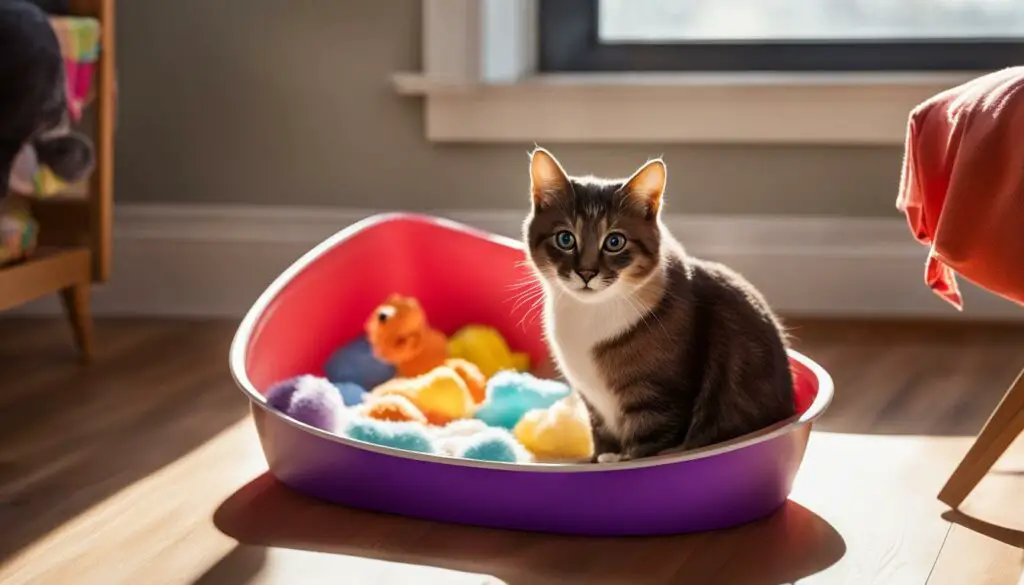
Testimonials
“I started placing treats near the litter box, and it made a significant difference! My cat now associates the litter box with something positive, and accidents have become rare.” – Jane L.
“Supervised play sessions near the litter box have been a game-changer for us. Our cat now happily uses the litter box without any issues.” – Mark T.
Monitoring Your Cat’s Behavior
Observing your cat’s behavior is essential in detecting early signs of urination issues. By paying close attention to their actions and habits, you can identify potential problems before they escalate. Here are some key behaviors to monitor:
- Frequency of Urination: Take note of how often your cat is using the litter box. An increase in frequency or urgency may indicate a urinary tract infection or other medical condition.
- Grooming Habits: Excessive grooming around the genital area can be a sign of discomfort or irritation. It’s important to investigate further if you notice your cat excessively licking or biting at themselves.
- Litter Box Preferences: Pay attention to your cat’s preference for one litter box over others. If they consistently avoid a particular box or show aversion to the litter, it may be a sign of a problem.
- Changes in Water Intake: Monitor your cat’s drinking habits. An increase or decrease in water intake can indicate underlying health issues such as kidney disease or diabetes.
- Changes in Behavior: Notice any shifts in your cat’s behavior, such as increased aggression, hiding, or loss of appetite. These changes may be related to stress or an underlying medical condition.
By keeping a close eye on your cat’s behavior, you can catch potential urination issues early on and seek appropriate veterinary care. Remember to consult with a veterinarian if you have any concerns or notice significant changes in your cat’s behavior.
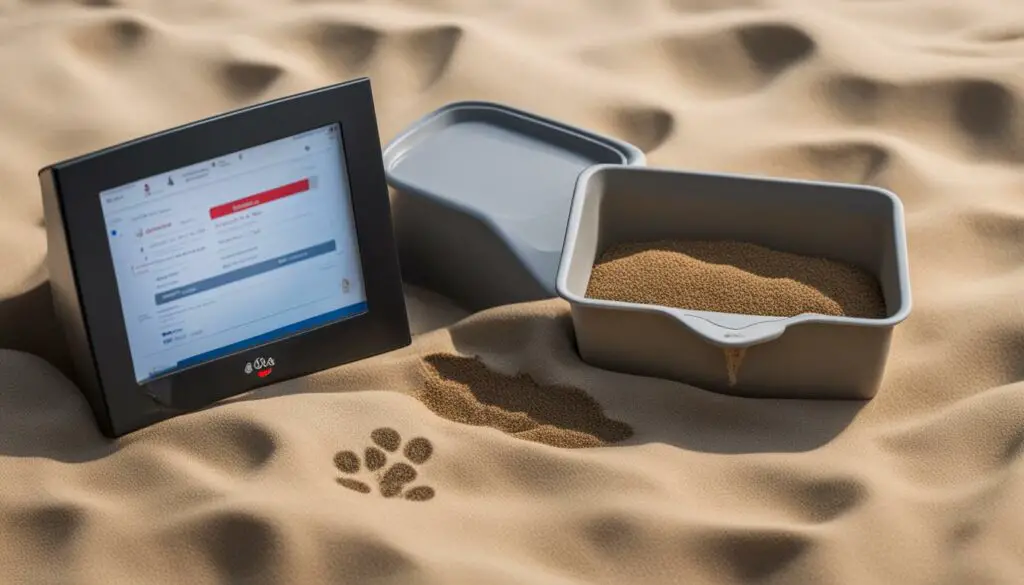
Common Signs of Urinary Tract Issues
When monitoring your cat’s behavior, certain signs may indicate urinary tract issues that require immediate attention:
- Straining to Urinate: If your cat is spending excessive time in the litter box or appears to be straining to urinate, it may be a sign of a blockage or urinary tract infection.
- Pain or Discomfort: Vocalizing or showing signs of pain while urinating is a red flag. Cats may cry out, hiss, or seem agitated during the urination process when experiencing discomfort.
- Blood in Urine: The presence of blood in your cat’s urine is a clear indication of a problem. If you notice reddish or pinkish discoloration, it’s crucial to seek immediate veterinary attention.
- Frequent Trips to the Litter Box: Cats with urinary tract issues often make frequent attempts to urinate, but only produce small amounts. This behavior is an indication that something is amiss.
If you observe any of these signs or suspect your cat may be experiencing urinary tract issues, consult with your veterinarian as soon as possible. Early detection and treatment can prevent further complications and ensure your cat’s well-being.
Providing Environmental Enrichment
Creating a stimulating environment for your cat is essential to prevent inappropriate urination. Environmental enrichment helps keep your cat mentally and physically engaged, reducing stress and unwanted behaviors. Here are some strategies to provide enrichment for your feline friend:
- Provide a variety of interactive cat toys to keep your cat entertained and active. Toys that mimic prey, such as feather wands or interactive treat puzzles, can be especially engaging.
- Set up scratching posts or boards in different areas of your home to satisfy your cat’s natural scratching instincts. This helps them stretch and tone their muscles, as well as keep their claws in good condition.
- Create vertical spaces, such as cat trees or wall shelves, to give your cat opportunities to climb and observe their surroundings from a higher vantage point. This helps them feel safe and secure.
- Introduce hiding spots, such as cozy cat beds or enclosed areas, where your cat can retreat to when they need privacy or a sense of security.
- Rotate toys and rearrange the environment periodically to provide novelty and keep your cat’s interest piqued.
By incorporating these environmental enrichment strategies into your cat’s daily life, you can promote their overall well-being and reduce the likelihood of inappropriate urination.
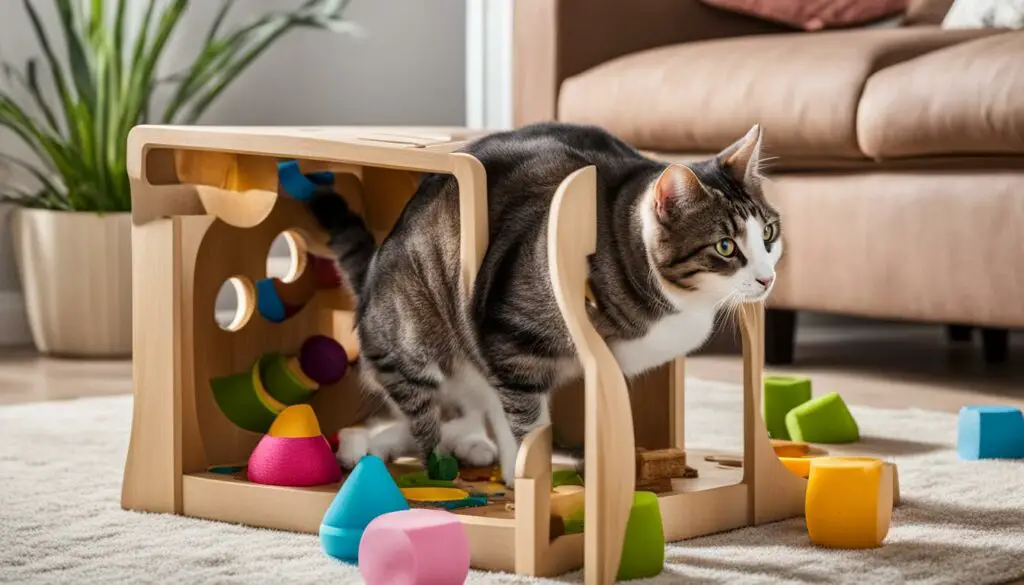
Table: Comparison of Cat Toys
| Toy Type | Description | Benefits |
|---|---|---|
| Feather wands | Toy with feathers attached to a string or wand | Stimulates natural hunting instincts, provides exercise |
| Interactive treat puzzles | Toys that require cats to solve puzzles to access treats | Mental stimulation, encourages problem-solving skills |
| Catnip toys | Toys stuffed with catnip | Offers sensory stimulation, promotes playfulness |
| Interactive laser pointers | Pointers that emit laser beams for cats to chase | Provides exercise, engages cats’ natural chase instincts |
| Puzzle feeders | Toys that dispense food when manipulated | Keeps cats mentally stimulated, slows down eating |
“Environmental enrichment plays a vital role in reducing stress and preventing inappropriate urination. By providing a stimulating environment with interactive toys, scratching posts, and vertical spaces, you can keep your cat mentally and physically engaged. It’s important to remember that each cat is unique, so observe their preferences and adjust the enrichment strategies accordingly. Creating a fulfilling environment for your feline companion can lead to a happier and healthier relationship.”
Creating a Safe Outdoor Space
If you have the means, creating a secure outdoor space for your cat can provide additional environmental enrichment. Consider building an enclosed patio or installing a cat enclosure in your yard. This allows your cat to experience the sights, sounds, and smells of the outdoors while remaining safe from potential dangers such as traffic or predators. Ensure the outdoor space is escape-proof and provides options for shade and shelter.
Consistency and Patience in Training
When it comes to training your cat and addressing behavioral issues like inappropriate urination, consistency and patience are key. Cats are independent creatures with their own unique personalities, so it’s important to approach training with understanding and compassion.
Consistency means establishing a routine and sticking to it. Set specific times for feeding, play sessions, and litter box maintenance. Make sure your cat knows where their litter box is located and keep it clean to encourage proper bathroom habits. By providing a consistent environment, you can help your cat feel secure and reduce stress-related urination problems.
Patience is vital when working with cats. It may take time for your cat to adjust to new routines or litter box strategies. Avoid punishing or scolding your cat for accidents, as this can create negative associations and make the problem worse. Instead, focus on positive reinforcement when your cat uses the litter box correctly. Offer treats, praise, and playtime to reward good behavior and reinforce positive associations with the litter box.
Remember, training a cat takes time and effort. It’s important to be patient and understanding throughout the process. Consistency, positive reinforcement, and a calm environment will go a long way in helping your cat develop good bathroom habits and prevent inappropriate urination on soft things.
Vet Assistance for Cat Urination Issues
If you have tried various solutions and your cat’s inappropriate urination persists, it’s crucial to seek professional medical assistance. A veterinarian can conduct a thorough examination, perform necessary tests, and diagnose any underlying medical conditions. They may recommend specific treatments or medications to address the issue effectively. Timely intervention by a veterinary professional can help improve your cat’s health and alleviate urination problems.
When it comes to cat urination issues, a veterinarian is the best resource for determining the root cause of the problem and providing appropriate medical intervention. They have the knowledge and expertise to identify any underlying medical conditions that may be contributing to your cat’s inappropriate urination. Whether it’s a urinary tract infection, kidney disease, or diabetes, a vet can perform the necessary tests to make an accurate diagnosis and develop a treatment plan tailored to your cat’s specific needs.
With the help of a veterinarian, you can explore a range of medical interventions that may help resolve your cat’s urination issues. This could involve medications to treat infections or manage chronic conditions, dietary changes to support urinary health, or even surgical interventions in certain cases. Your vet will guide you through the available options and recommend the most appropriate course of action based on your cat’s individual circumstances.
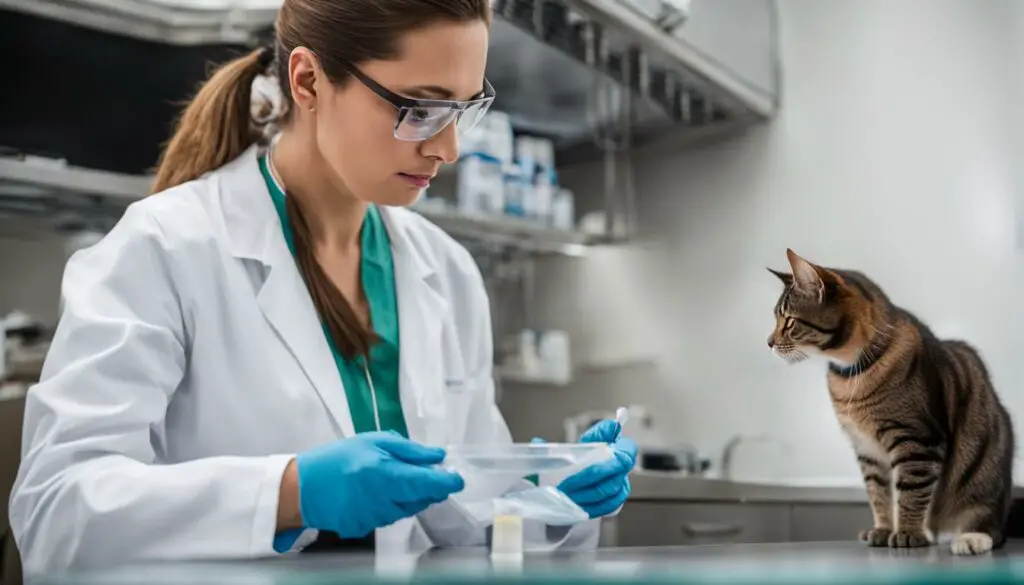
Seeking professional medical assistance is essential for ensuring the well-being of your cat and addressing any underlying health issues that may be contributing to their urination problems. By working closely with a veterinarian, you can find the most effective treatment plan and help your furry friend lead a happy and healthy life.
Conclusion
Dealing with a cat peeing on soft things can be frustrating, but there are solutions to prevent this behavior and maintain a harmonious relationship with your pet. By understanding the underlying causes, creating a conducive environment, and seeking professional help when necessary, you can address the issue effectively.
First, it’s important to approach the problem with empathy and compassion. Cats don’t pee on soft things to spite their owners; they are trying to communicate something. By identifying the reason behind the behavior, such as marking territory, inter-cat conflicts, litter aversion, or health issues, you can find appropriate solutions.
Creating a consistent routine, providing a stress-free environment, and maintaining cleanliness are crucial. Ensure that your cat’s litter box is in a quiet, private location with a litter type that they prefer. Use multiple litter boxes for multiple cats and keep them clean. Avoid sudden changes in their environment and provide plenty of toys and scratching posts for mental and physical stimulation.
If all your efforts to prevent inappropriate urination fail, seeking professional help is recommended. A cat behaviorist or a veterinary behaviorist can assess your cat’s behavior, identify underlying issues, and develop a customized plan for your cat’s specific needs.
Remember, preventing cat urination problems requires patience, understanding, and a proactive approach. By implementing these strategies, you can improve your cat’s behavior and ensure a happy and healthy relationship with your feline companion.
FAQ
Why is my cat peeing on soft things?
Cats may pee on soft things to mark their territory, due to inter-cat conflicts, litter aversion, or as a symptom of an underlying medical condition.
How can I stop my cat from peeing on soft items?
To prevent inappropriate urination, you can try using plug-in solutions, creating a comfortable environment for multiple cats, switching to a different type of litter, or seeking medical assistance if necessary.
Is cat urine outside the litter box a sign of a medical problem?
Yes, cats could pee on soft things as a result of certain medical conditions such as urinary tract infections, kidney disease, diabetes, or endocrine disorders. Consulting with a vet is important if you suspect a medical issue.
How many litter boxes should I have for multiple cats?
It is recommended to provide one litter box per cat, plus an extra box. Placing the litter boxes in different locations can help reduce conflicts and prevent territory marking.
What should I use to clean up cat urine accidents?
Enzyme cleaners specifically designed for cat urine odor and stains are recommended. Avoid using ammonia-based cleaners, as they can attract your cat to revisit the same spot.
What can I do if my cat continues to pee on soft things?
If other strategies have been unsuccessful, seeking professional help from a cat behaviorist or veterinary behaviorist can provide expert guidance and support to address the issue.
How can I create positive associations with the litter box?
Placing treats or toys near the litter box and engaging in supervised play sessions nearby can help make the litter box a rewarding area for your cat.
How can I prevent future incidents of inappropriate urination?
Maintaining a consistent cleaning routine, establishing a stress-free environment, and providing environmental enrichment can help prevent your cat from peeing on soft items.
When should I seek professional medical assistance for my cat’s urination problems?
If you have tried various solutions and your cat’s inappropriate urination persists, it is important to consult with a veterinarian to rule out any underlying medical conditions and receive appropriate treatment.
Source Links
- https://www.foundanimals.org/why-do-cats-pee-on-things/
- https://www.atlanticvetseattle.com/why-is-my-cat-peeing-on-laundry/
- https://be.chewy.com/why-is-my-cat-peeing-on-bed/

